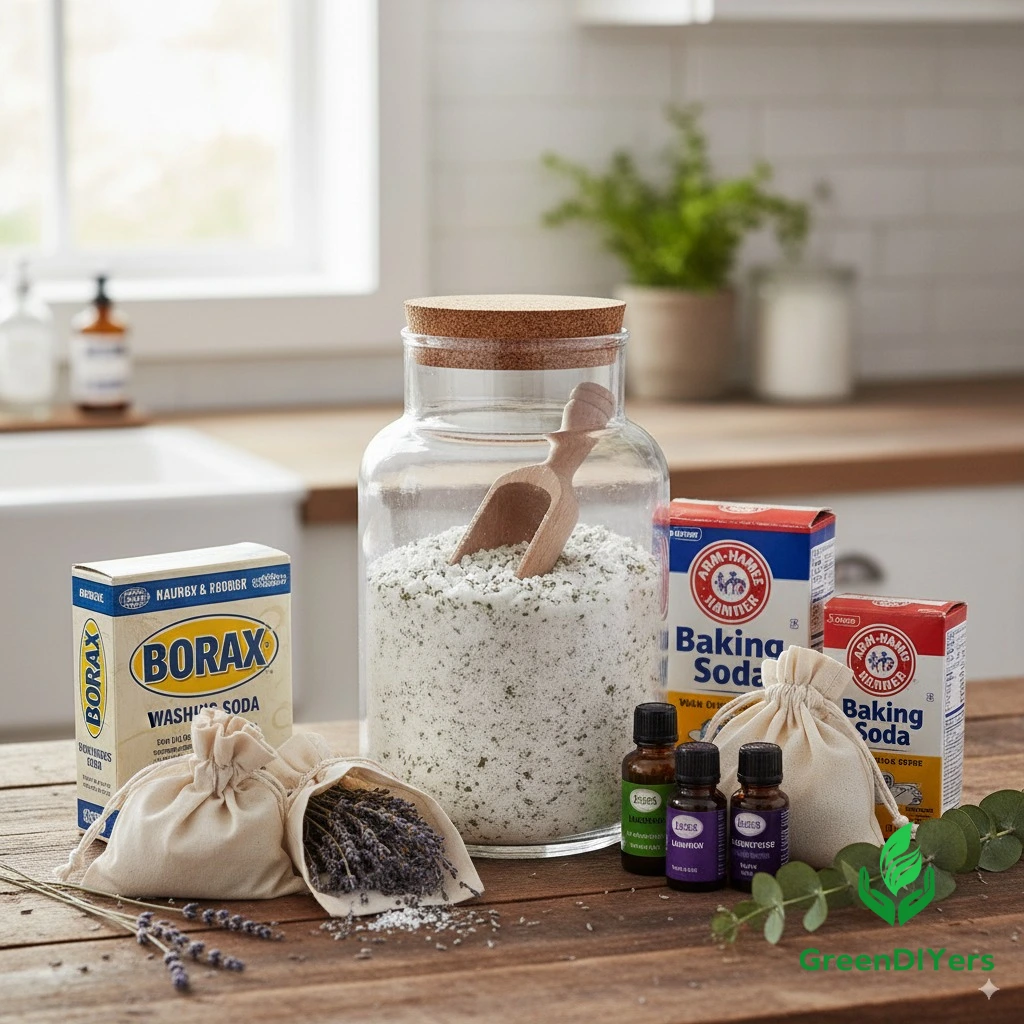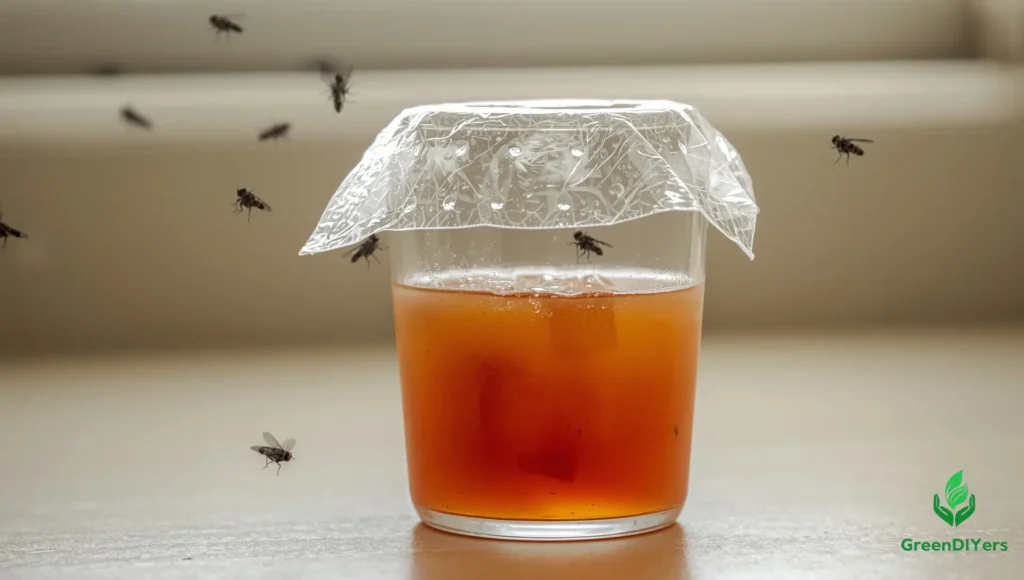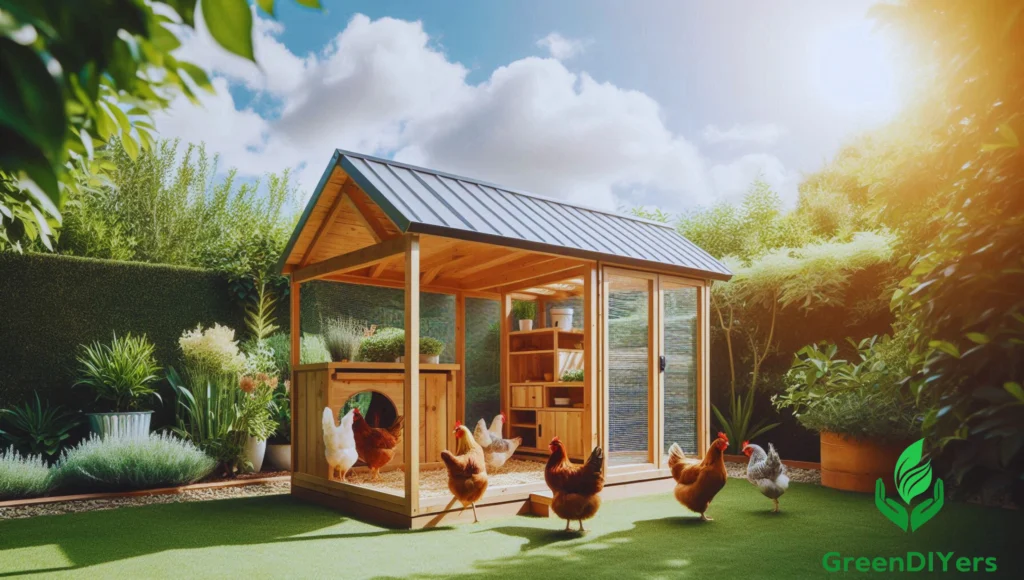Are You Tired of Spending a Fortune on Laundry Detergent?
Picture this: You’re standing in the detergent aisle, staring at a $15 bottle of laundry soap that’ll last maybe three weeks. Meanwhile, your sensitive skin is already dreading the harsh chemicals, and you’re wondering if there’s a better way.
Well, there is! DIY laundry detergent isn’t just a trendy homesteading hack – it’s a game-changing solution that puts you in control of what touches your family’s clothes and skin. Whether you’re looking to slash your household budget, create a more eco-friendly home, or finally find relief for sensitive skin, making your own natural laundry soap is easier than you think.
In this comprehensive guide, you’ll discover everything you need to know about homemade laundry detergent. We’ll walk through multiple proven recipes (powdered, liquid, and borax-free options), break down the real cost savings, troubleshoot common issues, and share pro tips that’ll make your DIY detergent outperform expensive store brands.
Ready to take control of your laundry routine? Let’s dive in!
Table of Contents
Why Make Your Own Laundry Detergent?
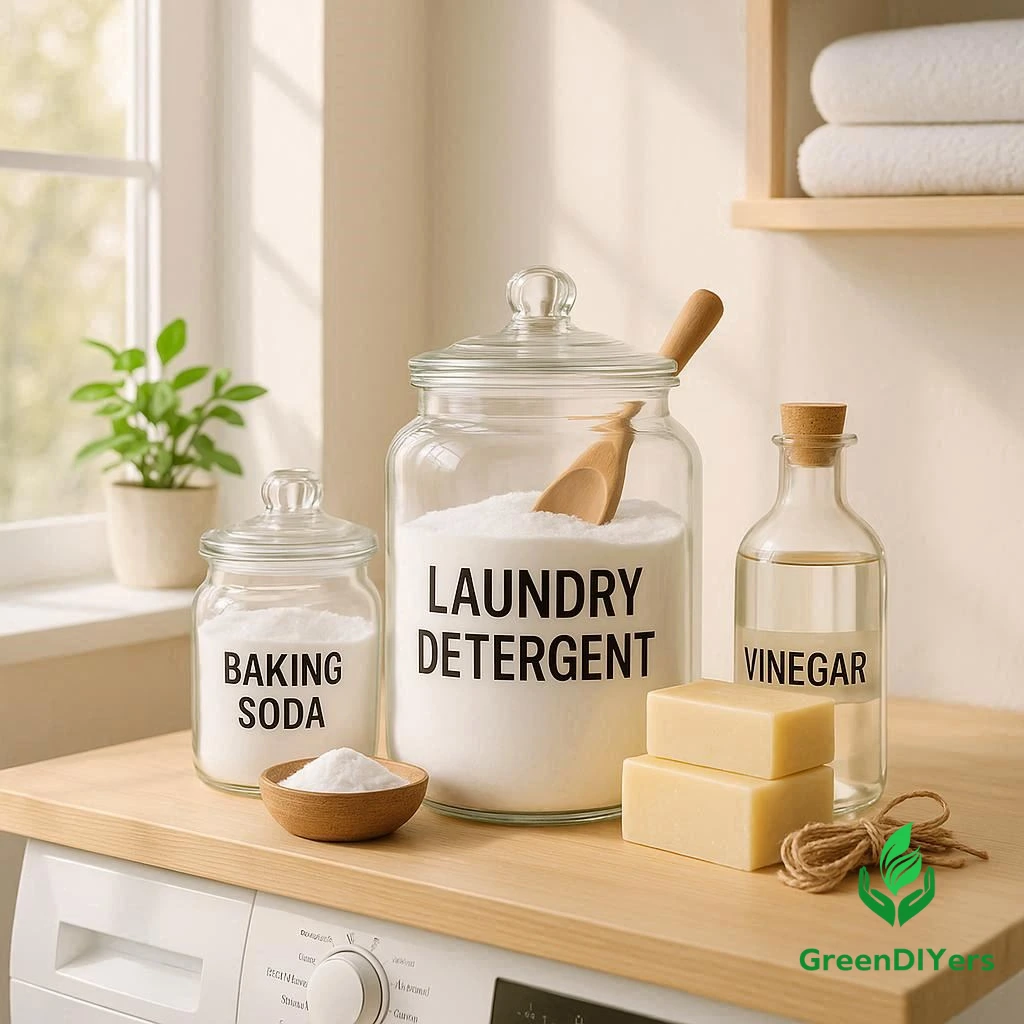
Cost Savings That Actually Matter
Let’s talk numbers. The average family spends $150-200 annually on commercial laundry detergent. With DIY laundry detergent, you can cut that cost by 80-90%.
Cost Comparison Per Load:
- Commercial detergent: $0.25-0.40 per load
- Homemade laundry detergent: $0.05-0.10 per load
- Annual savings: $120-180 for an average family
That’s real money back in your pocket – enough for a weekend getaway or a nice dinner out every month!
Ingredient Control & Health Benefits
Commercial detergents are loaded with chemicals you can’t pronounce: phosphates, synthetic fragrances, optical brighteners, and sulfates. These harsh additives can irritate sensitive skin, trigger allergies, and potentially disrupt hormones.
When you make natural laundry soap at home, you know exactly what’s going on your clothes. This is especially important for:
- Babies and children with delicate skin
- Anyone with eczema, allergies, or chemical sensitivities
- Families wanting to reduce exposure to potential endocrine disruptors
Environmental Impact
Every plastic jug of detergent contributes to our growing waste problem. By making your own eco-friendly laundry detergent, you’re:
- Eliminating dozens of plastic containers annually
- Using biodegradable ingredients that won’t harm waterways
- Reducing your carbon footprint (no shipping heavy liquid detergents)
- Supporting a more sustainable lifestyle
Complete Customization
Store-bought detergent is one-size-fits-all, but your laundry needs are unique. With homemade recipes, you can:
- Add essential oils for your favorite scent
- Adjust formulas for hard water
- Create sensitive skin laundry detergent without irritating additives
- Boost stain-fighting power for heavily soiled loads
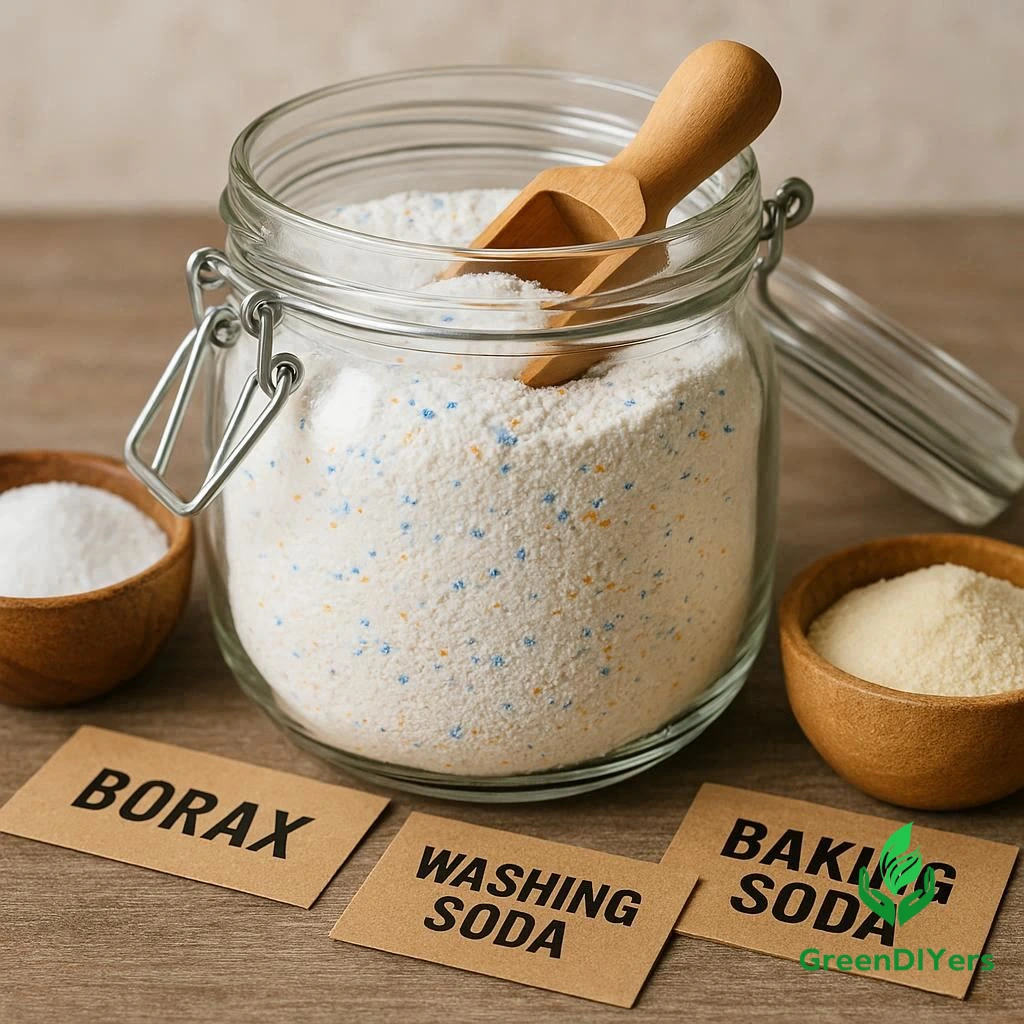
Essential Ingredients for DIY Laundry Detergent
Understanding your ingredients is key to DIY laundry detergent success. Let’s break down each component:
Washing Soda (Sodium Carbonate)
Purpose: This powerhouse ingredient softens water and boosts cleaning power by breaking down grease and stains.
Safety & Usage: Wear gloves when handling, as it can be drying to skin. You can find it in the laundry aisle or make your own by baking regular baking soda at 400°F for an hour.
Borax (Sodium Borate)
Purpose: A natural mineral that removes stains, neutralizes odors, and has disinfectant properties.
Safety & Usage: Despite internet myths, borax is safe for laundry use when handled properly. Use in well-ventilated areas and store away from children. It’s been used safely in households for over 100 years.
Baking Soda (Sodium Bicarbonate)
Purpose: This gentle ingredient neutralizes odors and acts as a mild abrasive for stain removal.
Safety & Usage: Completely safe and gentle on all fabrics. It’s the same baking soda you use in cooking!
Bar Soap Base
Purpose: Provides the cleaning action and helps create suds.
Options:
- Fels-Naptha: Traditional choice, excellent stain-fighting power
- Zote: Pink or white bars, great for sensitive skin
- Castile soap: Made from plant oils, perfect for those avoiding animal products
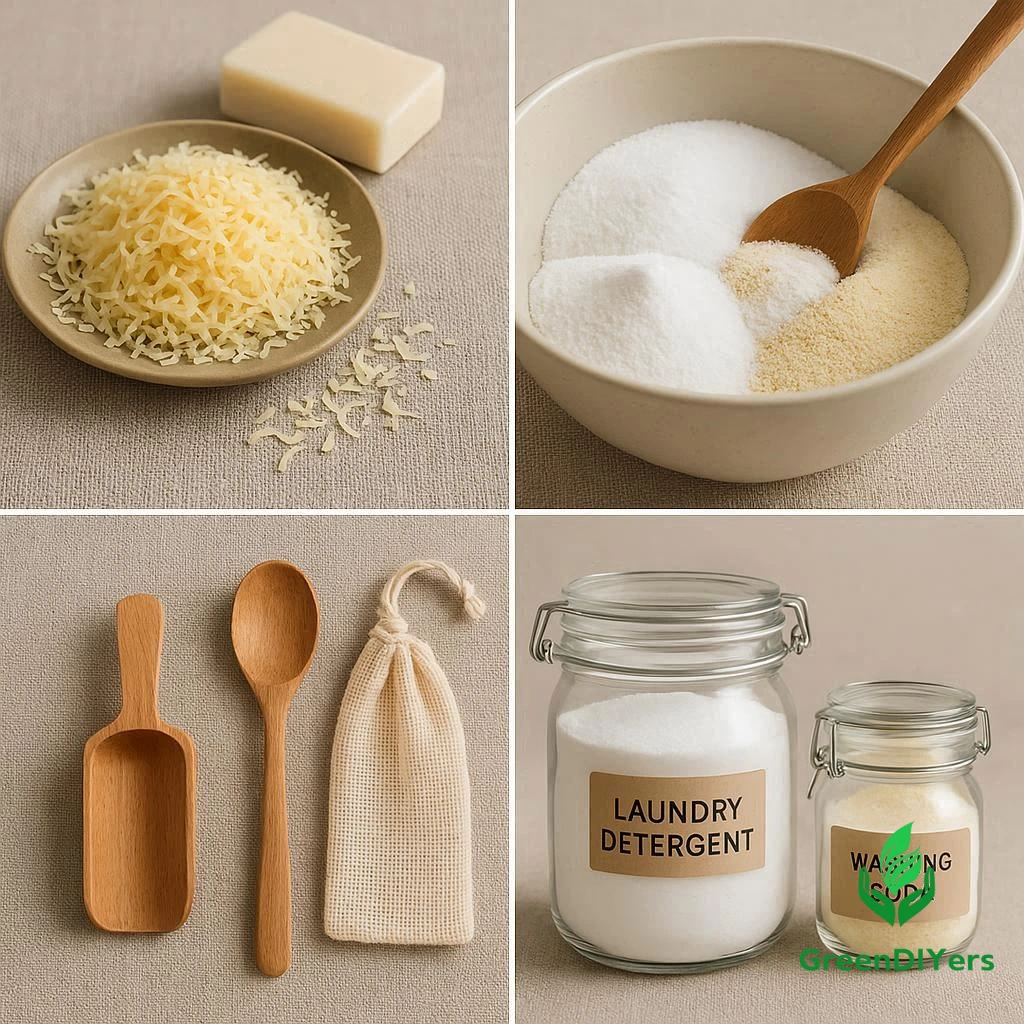
Optional Boosters
Essential Oils: Add 10-20 drops per batch for natural fragrance. Lavender, lemon, and tea tree oil also provide antibacterial benefits.
Oxygen Booster (Sodium Percarbonate): A chlorine-free bleach alternative that brightens whites naturally.
Salt: Epsom or sea salt can help soften water and preserve colors.
Ingredient Sourcing & Storage
Buy ingredients in bulk to maximize savings. Store in airtight containers in cool, dry places. Properly stored ingredients maintain potency for 1-2 years.
DIY Laundry Detergent Recipes
Classic Powdered DIY Laundry Detergent
Best for: General use, easy storage, beginners
Ingredients:
- 1 cup washing soda
- 1 cup borax
- 1 bar Fels-Naptha (grated)
Instructions:
- Grate the bar soap using a cheese grater or food processor
- Mix all ingredients thoroughly in a large bowl
- Store in airtight container
- Use 1-2 tablespoons per load
Pros: Long shelf life, takes up minimal space, very economical Cons: Requires grating soap, may need extra rinse in hard water
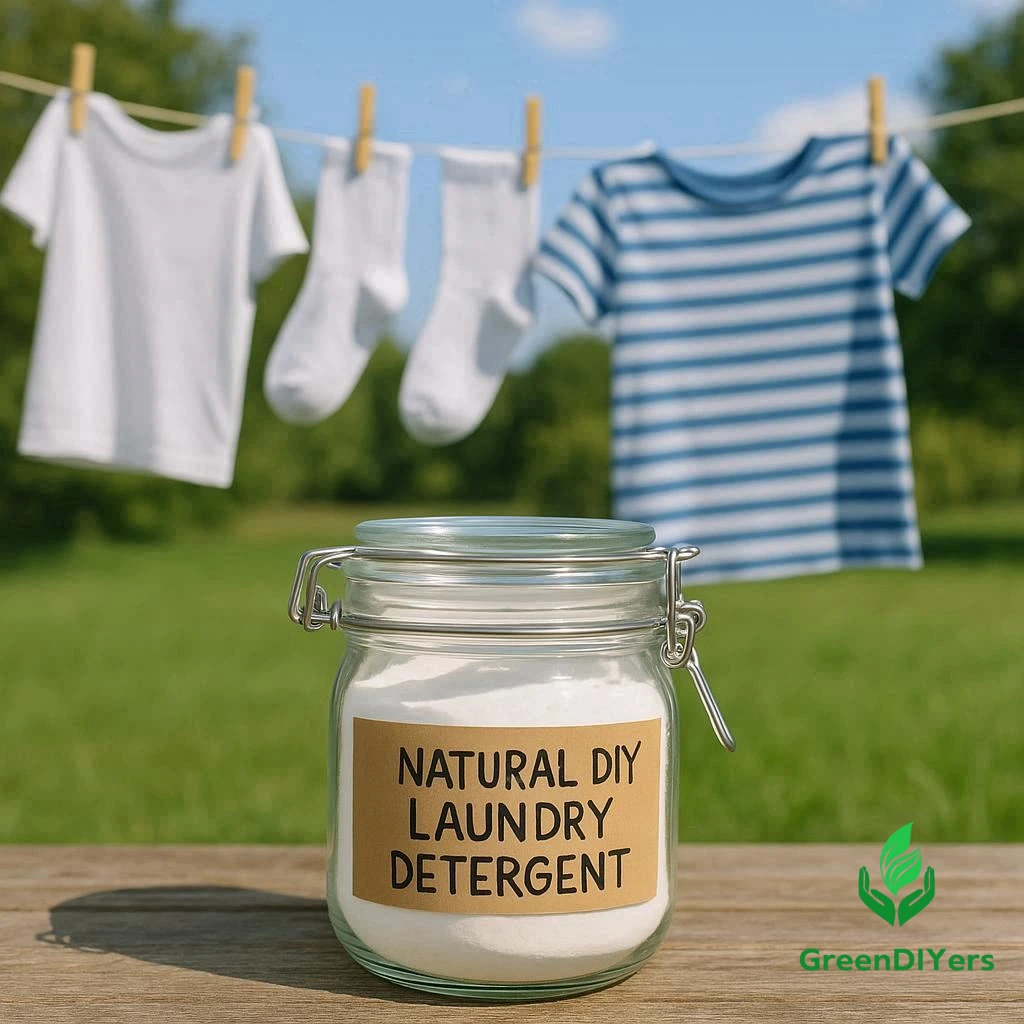
Liquid DIY Laundry Detergent
Best for: Those who prefer liquid, dissolves easily in cold water
Ingredients:
- 1 bar grated soap
- 1 cup washing soda
- 1/2 cup borax
- 3 gallons water
Instructions:
- Grate soap and dissolve in 4 cups boiling water
- Add washing soda and borax, stir until dissolved
- Pour into large container, add remaining water
- Let cool 24 hours (it will gel slightly)
- Use 1/2 cup per load, shake before each use
Pros: Dissolves instantly, familiar liquid format Cons: Takes up more storage space, shorter shelf life
Borax-Free DIY Laundry Detergent
Best for: Those avoiding borax, extremely sensitive skin
Ingredients:
- 2 cups washing soda
- 1 cup baking soda
- 1 bar grated Castile soap
- 1 cup oxygen booster (optional)
Instructions:
- Grate soap finely
- Mix all dry ingredients thoroughly
- Store in airtight container
- Use 2-3 tablespoons per load
Pros: Gentlest option, no borax concerns Cons: May need larger quantities for heavily soiled loads
DIY Laundry Pods/Tablets
Best for: Pre-measured convenience, gift-giving
Ingredients:
- 2 cups powdered recipe (your choice)
- 2-3 tablespoons white vinegar
Instructions:
- Mix powdered detergent with vinegar until moldable
- Press firmly into ice cube trays or silicone molds
- Let dry 24-48 hours
- Store in airtight container
- Use 1-2 pods per load
Pros: Pre-measured convenience, fun to make Cons: More time-intensive, may crumble if too dry
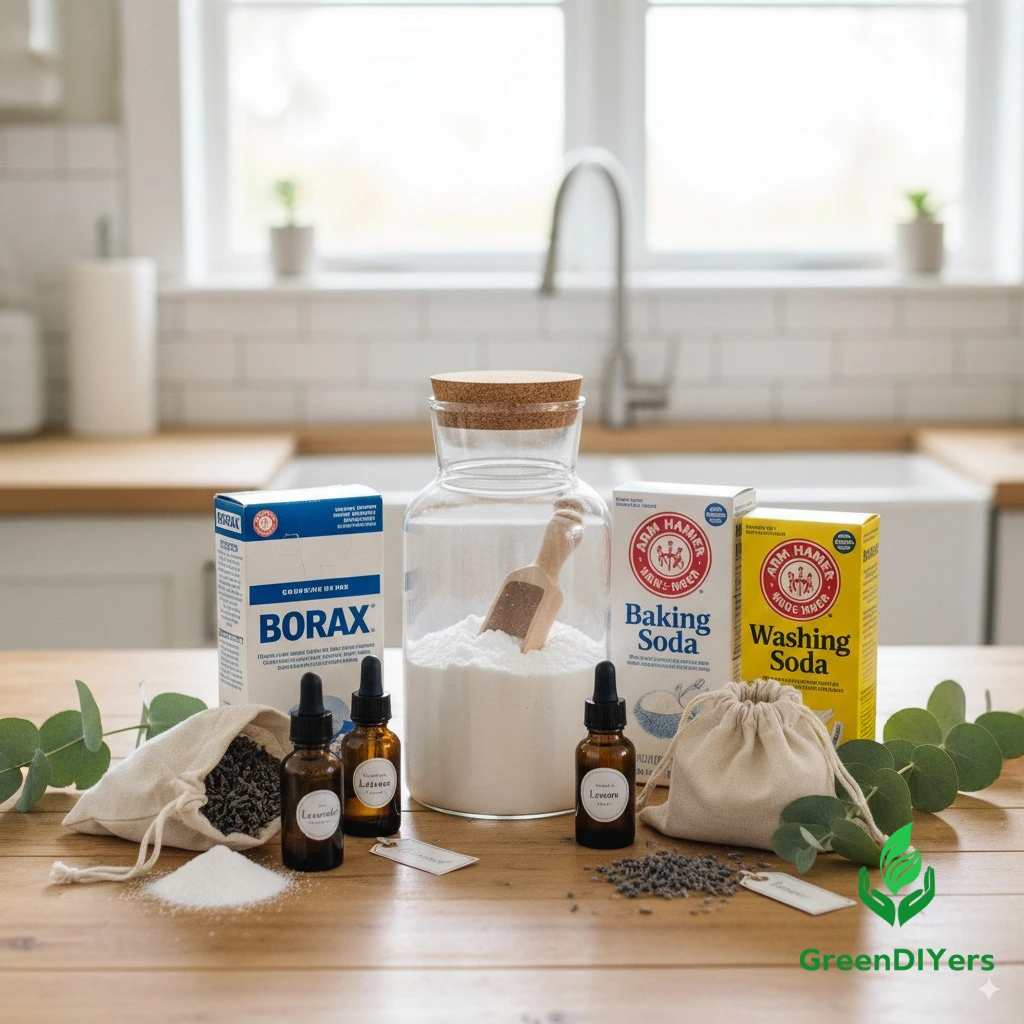
How to Use DIY Laundry Detergent Effectively
Dosage Guidelines
- Light soil: 1 tablespoon (powder) or 1/4 cup (liquid)
- Normal soil: 2 tablespoons (powder) or 1/2 cup (liquid)
- Heavy soil: 3 tablespoons (powder) or 3/4 cup (liquid)
Machine Compatibility
High-Efficiency (HE) Machines: Use 25% less detergent. The low-suds formula works perfectly.
Standard Machines: Use full recommended amounts. Add detergent before clothes for better distribution.
Hard Water Considerations
If you have hard water, add 1/2 cup white vinegar to the rinse cycle or increase detergent by 50%. Consider installing a water softener for best results.
Storage Best Practices
- Use airtight containers to prevent clumping
- Store in cool, dry places away from humidity
- Label with ingredients and date made
- Shelf life: 1-2 years for powder, 6 months for liquid
Advanced Tips, Tricks, and Troubleshooting
Stain Pre-Treatment Hacks
Create a paste with your powdered DIY laundry detergent and water for tough stains. Let sit 30 minutes before washing.
Natural Fabric Softener Alternatives
- Add 1/2 cup white vinegar to rinse cycle
- Use wool dryer balls to reduce static
- Skip fabric softener entirely – your clothes will be naturally softer!
Boosting Cleaning Power
- Add 1/2 cup baking soda for extra odor control
- Use hydrogen peroxide for whitening (3% solution)
- Pre-soak heavily soiled items in cold water
Common Issues & Solutions
Residue on Clothes:
- Use less detergent
- Add extra rinse cycle
- Check water hardness
Clothes Not Getting Clean:
- Increase detergent amount
- Use warmer water
- Pre-treat stains
Detergent Clumping:
- Store in drier location
- Add rice grains to absorb moisture
- Remix thoroughly before use
DIY Laundry Detergent FAQs
Is DIY laundry detergent safe for HE machines? Absolutely! The low-suds formula is actually ideal for HE machines. Use slightly less than recommended amounts.
Does it really clean as well as commercial brands? Yes! Independent testing shows homemade formulas clean just as effectively, often better than name brands.
How much does it truly save? The average family saves $120-180 annually – that’s a 80-90% reduction in detergent costs.
Will it leave a film on my clothes? Not when used correctly. If you notice residue, reduce the amount or add an extra rinse cycle.
How long does homemade laundry detergent last? Powder versions last 1-2 years; liquid versions last 6 months. Always store in airtight containers.
Can I use Castile soap instead of Fels-Naptha? Yes! Castile soap creates a gentler, more eco-friendly version perfect for sensitive skin.
Is Borax safe to use in laundry? When handled properly, borax is safe for laundry use. It’s been used in households for over a century. Always store away from children and use in ventilated areas.
Your Laundry Revolution Starts Now
Making your own DIY laundry detergent isn’t just about saving money – it’s about taking control of what touches your family’s skin, reducing your environmental impact, and proving that simple, natural ingredients often work better than expensive chemicals.
Start with the classic powdered recipe this weekend. You’ll be amazed at how clean your clothes get, how much money you save, and how empowering it feels to make something useful with your own hands.
Ready to revolutionize your laundry routine? Grab those ingredients and let’s get started! Your wallet, your skin, and the planet will thank you.
Have you tried making homemade laundry detergent? Share your experience and favorite recipes in the comments below!

